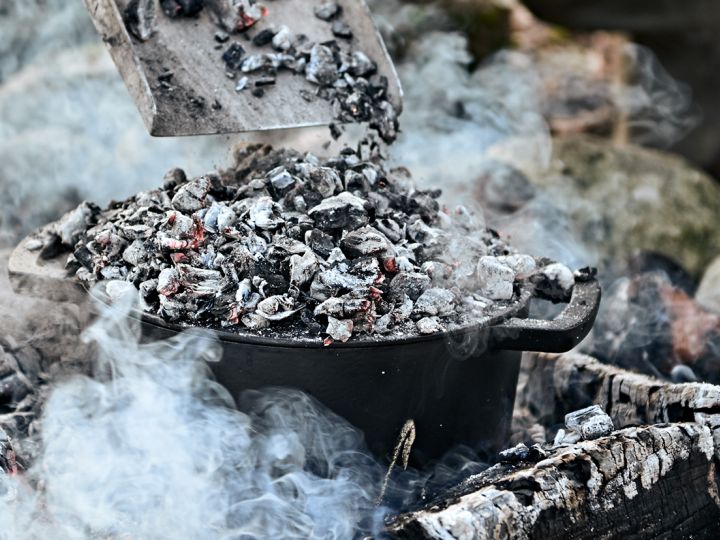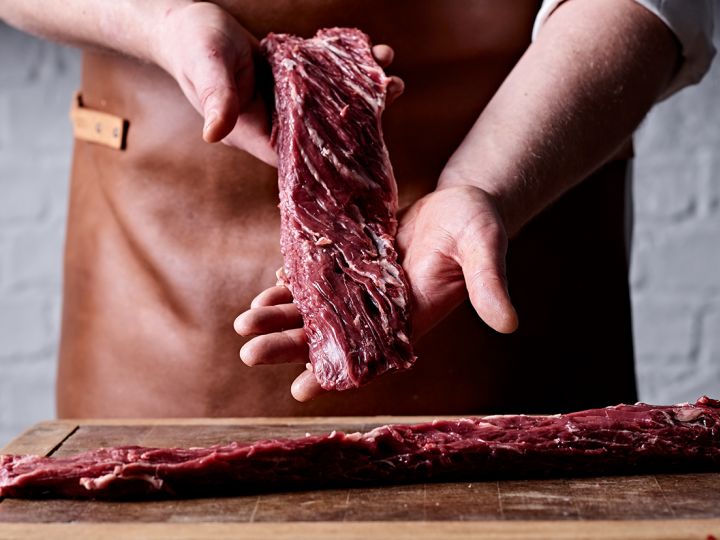When it comes to cooking over fire, the fuel you use is almost as important as the food you choose. You might even think of it as an ingredient in its own right. The flavour it imparts needs careful thought, the heat it creates needs to be monitored and the smoke output needs to be managed.
Cooking over fire can be fuelled by natural charcoal, dry hardwoods or sustainable engineered fuels. Your choice of the best fuel will depend on how you plan to cook (smoking, direct, indirect, offset or hanging) and what you plan to cook (meat, poultry, fish or vegetables).
To simply cook a steak or individual portions of meat, fish or vegetables, charcoal is your best bet. Engineered or not, look out for British charcoal sourced locally from a supplier who uses the cleanest production methods possible. Making charcoal is skilled and tricky, requiring fires to be closely monitored for hours to create the perfect burn.
Charcoal creates fantastic heat, burns cleanly with minimal smoke and has a neutral flavour. You can successfully cook for a couple of people on as little as 300g, easily controlling the heat by piling the coals up to create focus or spreading them out for a lower, even temperature. Charcoal is relatively inexpensive and generally consistent. If you haven’t tried engineered charcoals they’re worth considering but ensure they’re made sustainably and contain only wood products. As they burn incredibly hot with minimal smoke they’re ideal for cooking in enclosed spaces and can even be reused if placed into water to cool before being allowed to dry.
Charcoal shouldn’t be confused with briquettes – especially if you’re looking at engineered charcoals. We recommend you steer well clear of briquettes. They’re made from composite materials (not just wood) and often contain paper, peat and other combustibles that impart unwanted flavours into your food. The same advice goes for firelighters: choose natural options where possible, such as those made from wood wool, and avoid chemical accelerants when cooking over fire. We love to use products from Bluebell Coppice Charcoal, Devon Charcoal and Ben Short Charcoal. These are all producers local to us who are dedicated to artisanal methods and have a wealth of knowledge of this tricky craft.
Different tree species, from fruit woods to softwoods, have distinctive flavours and you’ll see different results if you use wood chippings or hardwood logs. For a hot burn that generates coals, hardwoods such as beech, birch, oak and ash are fantastic. These have great longevity and produce consistent heat while holding their shape and integrity. Beech and ash are favourites of ours as they create white-hot embers and large coals. Choose these woods when cooking over long periods as they impart a very gentle smokey flavour. Hanging large joints of pieces of meat directly or indirectly above the fire works brilliantly with these wood types.
Flavoursome woods including chestnut, apple, cherry, walnut and vine bring a perfumed smokiness to your food, but too much can leave an acrid flavour so use these sparingly. For simple grilling, sprinkle your charcoal with wood chips or small chunks of fruitwood soaked in water for an hour or so – you’ll get a kick of smoky flavour that’s not overpowering.
If cooking in a wood oven, kiln-dried hardwoods are a must. They deliver a clean, white-hot burn, permitting easier temperature control and longer, even cooking. When you’re slow-cooking food, think about which woods will bring complementary flavour. For example, shoulder of lamb or pork belly cooked overnight in a wood oven are enhanced by vine or apple woods. The fats that run through these cuts take on a delicately smoked taste, making them even more delicious.
Hot smoking is a different cooking technique altogether and requires a different type of fire. Here you want your wood selection to be top-notch, able to burn cleanly without the taint of blue haze. Finding a consistent size or grading of wood is key, as is keeping a good bed of coals to ensure the fire rolls constantly. Well-fatted, robust pieces of meat take fantastically to this style of cooking as it slowly breaks down the collagen and connective tissues in the muscles, rendering them juicy and yielding. Brisket and pork shoulders are prime candidates, but you can also hot smoke whole chickens, shoulders of lamb, porchettas and large steaks. More fibrous cuts meat will need low, slow cooking, with a brine baste or vinegar-style wash to season and tenderise the meat as it cooks. Large steaks can be smoked until they reach the desired temperature, then quickly sizzled over hot coals to ensure they have an amazing crust but perfectly pink interior. Using very dry, well-seasoned wood here is incredibly important. A significant part of the meat’s flavour comes from the fuel and the burn. Too hot and the meat will shrink and become tight; too cold and the meat won’t relax and become tender. Just the right amount of heat keeps the meat slowly cooking and tenderising, using the smoke to create a consistent flavour throughout the cut.
The type of cooking set-up you have also will determine the sort of fuel you’ll need to cook with. Ceramic kamado grills such as the Big Green Egg work best with charcoal. On a large grill area, an asado set-up or hearth-style cooking area where whole joints can be hung and slow-cooked, plenty of airflow is needed and hard woods give the best results, keeping the wood burning cleanly. If you have a small grill – such as a konro – just for cooking over intense heat, engineered charcoals are the way forward. Drum smokers and off-set barbecues work best with hard woods with a little experimentation of the size and grading of your fuels. As with anything fire or food-related, trial and error is the best way to learn. Try different cooking techniques combined with various fuels. Constantly gauge the heat from the fire, check the smoke and taste, taste, taste! Create balance with your flavours, using the smoke and fuel as an ingredient.
For more tips, check out our other blog post on how to barbecue.



